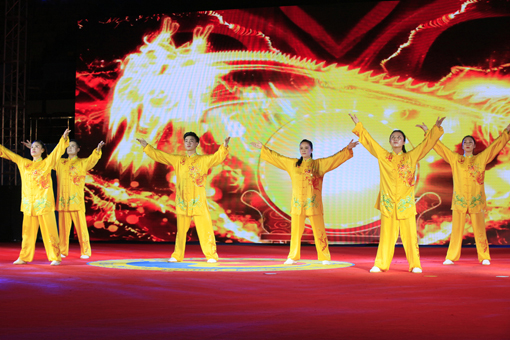
It is universally acknowledged that every sport has its own special preparations, while for Health Qigong, whether a static exercise or a dynamic exercise is employed, the only aim of the preparation is to concentrate the exerciser’s mind and to relax his body till he acquires the “Quiescence”. A quotation from Yi Zhuan said “Quiescence, hence the whole world shall be felt.”(From “Xi Ci” in Yi Zhuan) It means to concentrate on the nature through the quietness of the mind, and “meditate (not percept) directly the nature of Silence”, and then transfer it to the teaching and exercising of Health Qigong. Meanwhile, only quietness (Quiescence) can meditate out the nature of Silence and achieve the pleasant state of the mind. That is because “Quiescence” is regarded as one of the most important concepts in ancient Chinese aesthetic psychology. While in this essay, it is referred to the still and calm mental state achieved by helping the exerciser to eliminate the interferences by using various teaching methods. The exerciser’s quiescence is a combination of his concentration on the shallow characterization and his spiritual demands. Since the exerciser considers Health Qigong exercise as a creative activity to change his physical condition, it is reasonable for him to have a demand of spiritual enjoyment, in other words, the aesthetic demand. It is “borne in the process of re-experiencing the spiritual enjoyment achieved in the creative activities that is instructed by the consciousness to pursue spiritual enjoyment.” The positive objective of aesthetic experience is a naturally born child of the aesthetic demands. Then what is the positive objective? I shall start from the analysis of the exerciser’s “Quiescence” state. The essence of “Quiescence” is the transformation of external environment to the inner environment, while its characteristic is the external quietness and the internal dynamics. “The process to achieve ‘Quiescence’ is actually a process to transform the ‘external attention’ to the ‘internal transformation’. It is also a process of the transformation of observation to meditation, feelings to experience, receptions to aftertaste, and cognition to imagination.” The external quietness and the internal dynamics achieved in exerciser’s quiescence is a kind of positive psychological balance. “Our physical body contains only two states: the static and the dynamic. The static state is the root of the dynamic, while it is from the dynamic state that the static state is born.”(From Analects of Zhuzi) Through “Three Regulations”, the exerciser guides the external quietness to the inner dynamics and achieves the transformation inner dynamics to external quietness. With a coordinative interaction of the quietness and dynamics, the quietness gives birth to dynamics. Thereby, the exerciser’s dynamic psychological balance is achieved, and the foundation of the production of aesthetic experience is laid. This state shall be followed by the state produced in the meditations of “Mind Regulation” in Health Qigong, that is, the state in which “concentration is gathered by silence, the mind is connected to the eternal line of time; move quietly, and the sight reaches thousands of miles.”(From “Mental State” in Wen Xin Diao Long) The exerciser’s external empty is transformed to the internal sights. The concentration of the inner world enables him to fly his spirit high over the physical world and to achieve a spiritual meditation beyond time and space. That’s how the aesthetic transcendence is produced. Aesthetic transcendence is a transcendence of reality and a clarification of the truth. It is characterized by the coordinative nature of transcendence and aesthetics, which means the abandon of the sensitive world. It is the key to set free the exerciser’s inner soul, and to refresh every inch of his body. So he shall be fully involved in the Qigong exercise, and he shall forget the around world and transcendence the bitterness of life, and then finally get rid of the fame and fortune in the secular world. It is actually a baptism of the exerciser’s mind and soul, a natural outcome of the exerciser’s “quiescence”. It is the aesthetic transcendence that involves the exerciser’s whole body into the state and inspires his every sensory feeling. Thereby, the boundary between different physical organs is broken, and thus the organs are refreshed.
So if the teacher and the exerciser want to achieve the aesthetic transcendence, they shall achieve firstly the “Quiescence” because it is the only way to transform them to the aesthetic Subject. “Quiescence” is considered to be “a method to appreciate Dao with a clear and quiet heart, or an aesthetic psychology state to calm the exerciser’s mind and get rid of his desires.” Of course, the quiescence is not naturally born to the Health Qigong teacher or the exerciser; it is the stimulation of a long course of practice with reading, learning and thinking. Meanwhile, “Quiescence” does not equal to sitting still, it is an exercise involved in nature-it means to breath with all the living things in the universe, to renew the old QI with fresh one, to clear and calm one’s mind and to reach the dynamics in the quietness. Thereby the exerciser shall “…dredge the inner organs and refresh his soul”, and thus an aesthetic perspective shall be produced, and then the aesthetic transcendence shall be achieved.
(By Si Hongyu)

